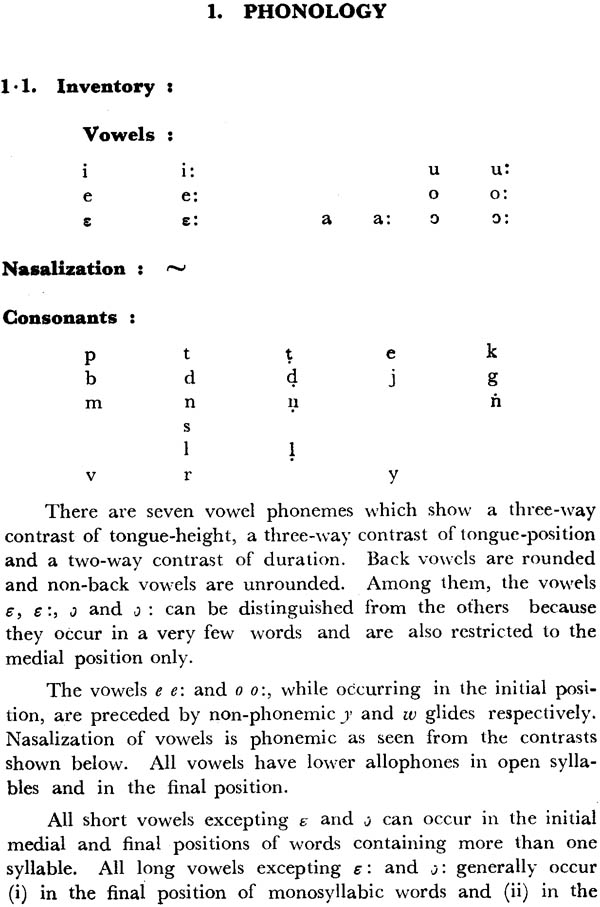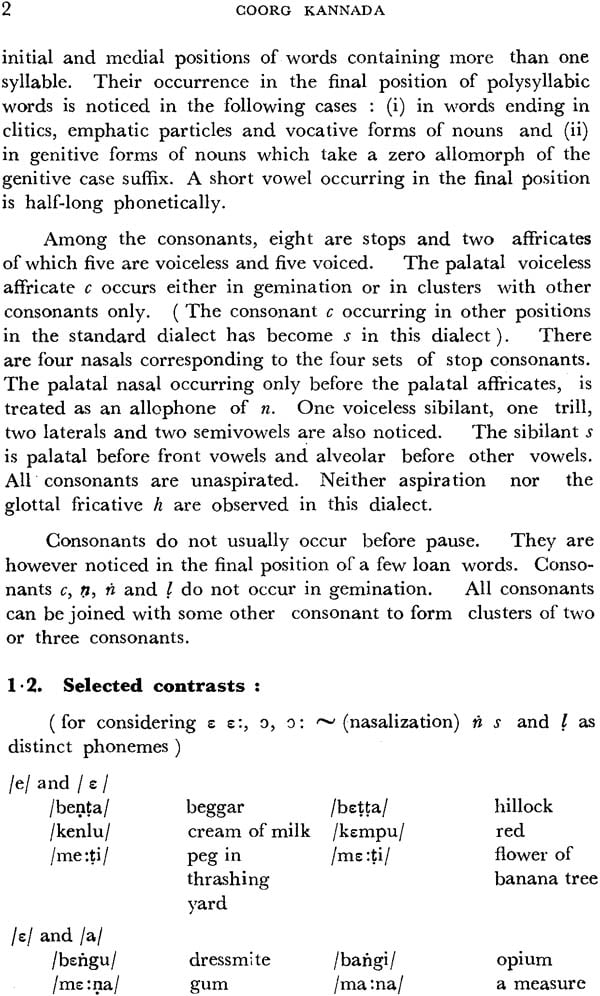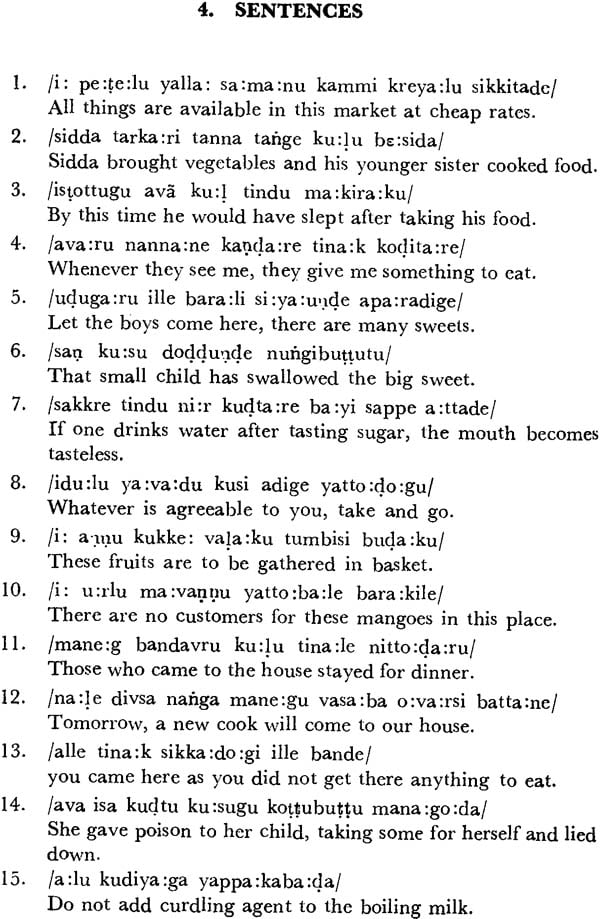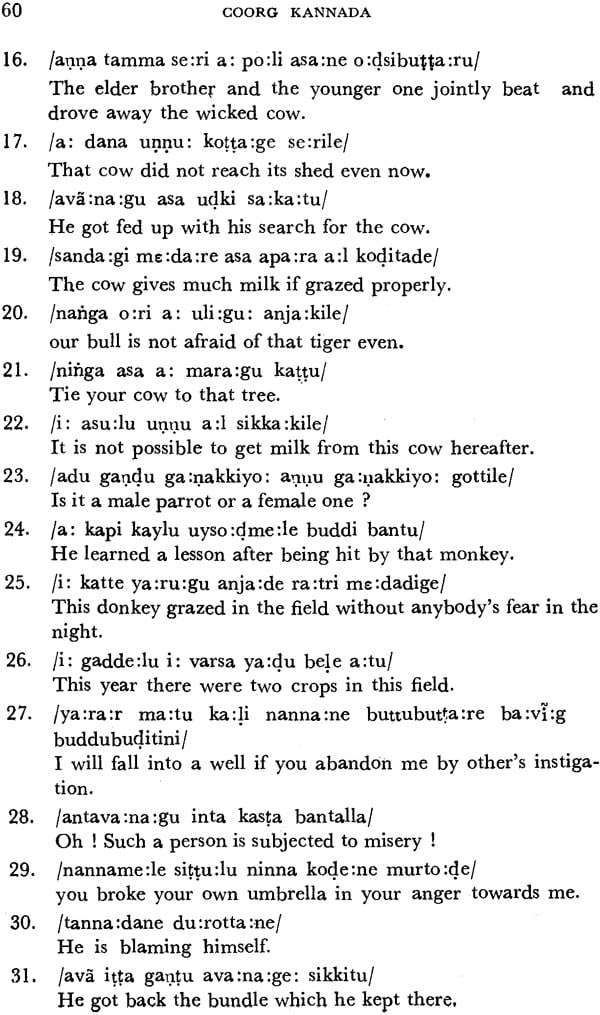
Coorg Kannada: Jenu Kuruba Dialect (An Old and Rare Book)
Book Specification
| Item Code: | NAL897 |
| Author: | U. P. Upadhyaya |
| Publisher: | Deccan College Postgraduate and Research Institute |
| Language: | English |
| Edition: | 1971 |
| Pages: | 96 |
| Cover: | Paperback |
| Other Details | 9.0 inch X 6.0 inch |
| Weight | 120 gm |
Book Description
The dialect of Kannada described here is the one spoken by the Jenu Kurubas residing in a hilly district called Coorg on the South Western border of the Mysore State. This district is predominantly populated by the Kodagu speaking people. Three sects of the Kuruba tribe reside in the forests of this district. Of These, two, namely Jenu Kuruba and Ane Kuruba speak a dialect of Kannada while the third, namely Betta Kuruba speak a language of its own. Collection of the honey from the forests was the main occupation of the Jenu Kuruba tribe as the name Jenu ‘honey’ suggests. They are now engaged in manual labour and agriculture in addition to their traditional profession. A sketch of the Kannada dialect spoken by the Jenu Kutubas residing in the tribal settlement of Nanjarajapatna, a village about twenty-five miles east of Mercara is presented I the following pages. The data was collected and tape-recorded during the summer of 1967 at Nanjarajapatna.
The following are some of the characteristics of this dialect which are of special importance.
The vowel a occurring in the second non-final syllable is lengthened provided it is not followed by a consonant cluster e.g. jaga:li ‘verandah’ aga:lu ‘day time’ kecca:lu ‘under’ etc. All base-final vowels are lengthened before the plural suffix, case suffixes and augments beginning with a non-geminated consonant. e. g. vala:ga ‘fields’ gida:da ‘plant’s’ etc. The vowel o becomes a after an initial m. e. g. mala ‘rabbit’ matte ‘egg’ manne ‘day-be-fore-yesterday’ etc. The vowel e and e: have become a and a: respectively when followed by a retroflex sound. e.g. ba:da ‘not wanted’ ka:lu ‘to listen’ batta ‘hillock’ annu ‘girl’ ali ‘to pull’ kala: ge ‘below’ ada ‘left’ anne ‘oil’ etc. In such contexts the vowel a is pronounced as slightly retroflexed the speech of the aged persons of the community. The vowel e has become a after an initial n. e. g. nala ‘floor’ nagi ‘to jump’ nallu ‘shadow’’ nani ‘to think’ etc. Exceptions noticed to such phonological correspondences may be due to borrowings from the standard dialect.
Initial h is regularly lost. The consonants c and s contrast only in germination and after other consonants. In all other environment c and s have merged into a single sibilant phoneme which is palatal before front vowels and alveolar before other vowels. e.g. se:lu ‘scorpion’ [se:lu] sinna ‘gold’ [sinna] sanda ‘beautiful’ su:ri ‘knife’ sa:pe ‘mat’ etc. Assimilation of nasal to the following homorganic stop is an interesting feature e.g. macca ‘cot’ bikki ‘fire’ miccu ‘lightening’ kukkuma ‘safron’-gitta ‘than’ etc.
In set of personal suffixes occurring after the past stem, the distinction between masculine and feminine singular in third person is absent. e. g. kudta ‘he or she drank’. Though there is a series of personal suffixes occurring after the present stem showing person and number distinction and also gender distinction for third person like the standard dialect, this dialect also uses the suffix –ige without any person, number or gender distinction. e. g. kuditige ‘ I, we, you, he she, it or they drink or drinks’. The root iru ‘to be’ has the following additional forms in present tense which show the normal gender-number distinction, but no person distinction whatsoever. e.g. avnige mas. Sg. in all persons, avlige fem. sg. in all persons, adige neuter, sg. in all persons, avrige mas. fem. pl. in all persons, avige neuter pl. in all persons. Final u of verbal bases has become i before the non-past suffix t e. g. idu ‘to keep’ iditini ‘I keep’, Sa:ku ‘to nurse’ sa:kitini’ I nurse’ etc. Past tense suffix has the allomorph t after many bases of the type CVCV ending in i e. g. kudte ‘I drank’ tagte ‘I took out’ etc. Concessive, potential and infinitive forms end in the suffix a:li, a:ku and a:le respectively as in kudiya:li ‘let him, her, them, it drink’ kudiya:ku ‘one must drink’ kudiya: le ‘for drinking’ etc.
The first and second person plural pronouns of this dialect are nanga ‘we’ and ninga ‘you (pl)’. The plural suffix galu has dropped its second syllable lu in this dialect. e. g. mane:ga ’houses’. The dative case suffix is kku after numerals and neuter singular pronouns an gu elsewhere. It is interesting to note that unlike the standard dialect, word ending in a and denoting irrational beings take gu as the dative suffix e. g. mara:gu ‘to the tree’. The locative case suffix is lu after all bases. e. g. de:sa:lu ‘in the country‘ ga:di:lu ‘in the cart’ mane:lu ‘in the house’ etc.
My sincere thanks are due to Dr. S. M. Katre, Dr. H. S. Biligiri and Dr. D. N. Shankara Bhat for their encouragement and guidance.
| 1 | Phonology | |
| 1.1. | Inventory. | 1 |
| 1.2. | Contrasts. | 2 |
| 1.3. | Description. | 3 |
| 1.4. | Clusters. | 5 |
| 2 | Morphology. | |
| 2.1. | Verbs. | 8 |
| 2.1.1. | Bases. | 9 |
| 2.1.2. | Classification of bases. | 11 |
| 2.1.3. | Sample Paradigms. | 11 |
| 2.1.4. | Finite Forms. | 13 |
| 2.1.5. | Non-finite Forms. | 22 |
| 2.1.6. | Basa iru 'to be'. | 23 |
| 2.1.7. | Modals. | 25 |
| 2.1.8. | Reflexive. | 25 |
| 2.1.9. | Negative. | 26 |
| 2.1.10. | Continuous and Perfect Forms | 27 |
| 2.2. | Nouns. | 28 |
| 2.2.1. | Simple Bases. | 28 |
| 2.2.2. | Derived Bases. | 29 |
| 2.2.3. | Plural Forms. | 33 |
| 2.2.4. | Case-suffixes. | 35 |
| 2.2.5. | Sample Paradigms. | 42 |
| Texts. | 43 | |
| Sentences. | 59 | |
| Vocabulary. | 65 |









